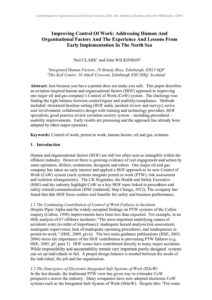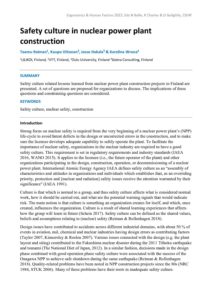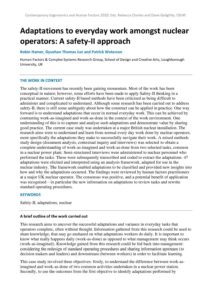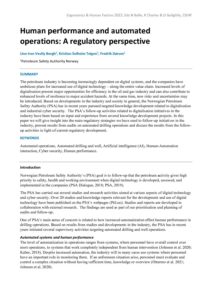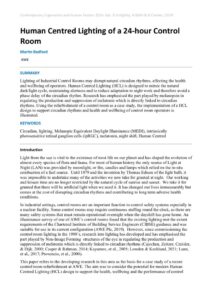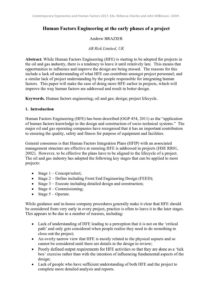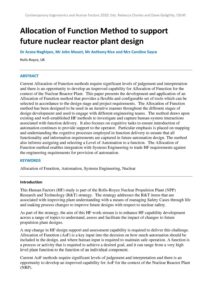Energy
Improving Control Of Work: Addressing Human And Organisational Factors And The Experience And Lessons From Early Implementation In The North Sea
| Document | Author Neil CLARK and John WILKINSON |
| Abstract Just because you have a permit does not make you safe. This paper describes an aviation-inspired human and organisational factors (HOF) approach to improving one major oil and gas company’s Control of Work (CoW) system. The challenge was finding the right balance between control/rigour and usability/compliance. Methods included: structured baseline setting (HOF audit, incident review and survey); active user involvement; collaborative design with training and technology providers, HOF specialists; good practice review (aviation sector); system – including procedural – usability improvements. Early results are promising and the approach has already been adopted by other major operators. |
Safety culture in nuclear power plant construction
| Document | Author Teemu Reiman, Kaupo Viitanen, Jesse Hakala & Karolina Wrona |
| Abstract Safety culture related lessons learned from nuclear power plant construction projects in Finland are presented. A set of questions are proposed for organizations to discuss. The implications of these questions and constraining questions are considered. |
Adaptations to everyday work amongst nuclear operators: A safety-II approach
| Document | Author Robin Hamer, Gyuchan Thomas Jun and Patrick Waterson |
| Abstract The safety-II movement has recently been gaining momentum. Most of the work has been conceptual in nature; however, some efforts have been made to apply Safety-II thinking in a practical manner. Current safety-II based methods have been criticised as being difficult to administer and complicated to understand. Although some research has been carried out to address safety-II, there is still some ambiguity about how the construct can be applied in practice. One way forward is to understand adaptations that occur in normal everyday work. This can be achieved by contrasting work-as-imagined and work-as-done in the context of the work environment. One understanding of this is to capture and analyse such adaptations and demonstrate value by sharing good practice. The current case study was undertaken at a major British nuclear installation. The research aims were to understand and learn from normal every day work done by nuclear operators, more specifically the adaptations they make to successfully navigate their work. A mixed methods study design (document analysis, contextual inquiry and interviews) was selected to obtain a complete understanding of work-as-imagined and work-as-done from two selected tasks, common in a nuclear power plant. Semi-structured interviews were administered to nuclear personnel who performed the tasks. These were subsequently transcribed and coded to extract the adaptations. 47 adaptations were elicited and interpreted using an analysis framework, adapted for use in the nuclear industry. The framework enabled adaptations to be classified and provided new insights into how and why the adaptations occurred. The findings were reviewed by human factors practitioners at a major UK nuclear operator. The consensus was positive, and a potential benefit of application was recognised – in particular the new information on adaptations to review tasks and rewrite standard operating procedures. |
Human performance and automated operations: A regulatory perspective
| Document | Author Linn Iren Vestly Bergh, Kristian Solheim Teigen & Fredrik Dørum |
| Abstract The petroleum industry is becoming increasingly dependent on digital systems, and the companies have ambitious plans for increased use of digital technology – along the entire value chain. Increased levels of digitalisation present major opportunities for efficiency in the oil and gas industry and can also contribute to enhanced levels of resilience to major accident hazards. At the same time, new risks and uncertainties may be introduced. Based on developments in the industry and society in general, the Norwegian Petroleum Safety Authority (PSA) has in recent years pursued targeted knowledge development related to digitalisation and industrial cyber security. The PSA’s follow-up activities related to digitalisation initiatives in the industry have been based on input and experience from several knowledge development projects. In this paper we will give insight into the main regulatory strategies we have used to follow-up initiatives in the industry, present results from audits on automated drilling operations and discuss the results from the follow-up activities in light of current regulatory development. |
Human Centred Lighting of a 24-hour Control Room
| Document | Author Martin Redford |
| Abstract Lighting of Industrial Control Rooms may disrupt natural circadian rhythms, affecting the health and wellbeing of operators. Human Centred Lighting (HCL) is designed to mimic the natural dark/light cycle, maintaining alertness and to reduce adaptation to night work and therefore avoid a phase delay of the circadian rhythm. Research has emphasised the part played by melanopsin in regulating the production and suppression of melatonin which is directly linked to circadian rhythms. Using the refurbishment of a control room as a case study, the implementation of a HCL design to support circadian rhythms and health and wellbeing of control room operators is illustrated. |
Human Factors Engineering at the early phases of a project
| Document | Author Andrew BRAZIER |
| Abstract While Human Factors Engineering (HFE) is starting to be adopted for projects in the oil and gas industry, there is a tendency to leave it until relatively late. This means that opportunities to influence and improve the design are being missed. The reasons for this include a lack of understanding of what HFE can contribute amongst project personnel; and a similar lack of project understanding by the people responsible for integrating human factors. This paper will make the case of doing more HFE earlier in projects, which will improve the way human factors are addressed and result in better design. |
Allocation of Function Method to support future nuclear reactor plant design
| Document | Author Dr Arzoo Naghiyev, Mr John Mount, Mr Anthony Rice and Mrs Caroline Sayce |
| Abstract Current Allocation of Function methods require significant levels of judgement and interpretation and there is an opportunity to develop an improved capability for Allocation of Function for the context of the Nuclear Reactor Plant. This paper presents the development and application of an Allocation of Function method that provides a flexible and configurable set of tools which can be selected in accordance to the design stage and project requirements. The Allocation of Function method has been designed to be used in an iterative manner throughout the different stages of design development and used to engage with different engineering teams. The method draws upon existing and well-established HF methods to investigate and capture human-system interactions associated with function delivery. It also focuses on cognitive tasks to ensure introduction of automation continues to provide support to the operator. Particular emphasis is placed on mapping and understanding the cognitive processes employed in function delivery to ensure that all functionality and information requirements are captured in future automation design. The method also informs assigning and selecting a Level of Automation to a function. The Allocation of Function method enables integration with Systems Engineering to trade HF requirements against the engineering requirements for provision of automation. |

